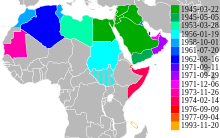(Japanese Version)
(Arabic Version)
Chapter 1 Wave of nationalism and socialism (1945-1956)
2. Formation of the Arab League
World War II had continued for 6 years starting from German invasion to Poland in 1939 till Japanese surrender in 1945. The battlefield expanded in Europe, Southeast Asia, Far East and the Pacific Ocean. Middle Eastern countries evaded the battle. They did not belong either to the Allied Powers nor the Axis Countries during early stage of the war. Iraq and Iran participated to Allied Powers in 1943. Turkey, Egypt, Saudi Arabia and other countries participated in 1945 when the result of the war almost apparent to the favor of Allied Powers. In the World War II Germany faced enemies on both west and east Europe. Britain, the United States and France were in Western Europe, and USSR was in Eastern Europe. Germany could not spare its force to the Middle East. That was the reason why the Middle East was out of the battlefield during the war.
The situation of the Middle Eastern countries during the first half of the 20th century could be described as follows. Turkey had transformed itself into a republic state after the fall of Ottoman Empire in 1923. It has changed into secularistic state from caliphate state. In Iran, Reza Shah , a General of the Persian Cossack Brigade, took over the power by the coup d'etat in 1921. He established the Pahlavi dynasty. During postwar era, Iran has been a pro-Western dictatorship monarchy state until 1979. Egypt, one of the three big countries in the Middle East, survived World War II as Muhammad Ali Dynasty which was half-independent state from the Ottoman Empire. UK had been maintaining strong influence. Other small and medium-sized countries like Iraq, Jordan and Palestine were mandated by UK, and Syria and Lebanon were under the mandate of France.
Saudi Arabia was the only one country that has escaped from the control of UK and France. Kingdom of Saudi Arabia was established in 1932. Saudi Arabia could keep independence reigning the most part of the Arabian Peninsula. UK and France did not show the strategic interest of the Arabian Peninsula. It was the reason why Saudi Arabia could keep the independence.
It was the United States who was aware of the value of Saudi Arabia. The US oil company found a big oil field in the eastern province of Saudi Arabia in 1941 just when the World War II started. The United States correctly recognized the future value of oil, and aimed to secure Saudi Arabian crude oil. Just before the end of the World War II, President Roosevelt met with King Abdulaziz of Saudi Arabia on the ship of the Suez Canal just after the Yalta meeting and before returning home. This fact was a clear evidence that US put weight on Saudi Arabia. The United States was not silly to colonize Saudi Arabia.
(To be continued ----)
By Areha Kazuya
Home Page: OCIN INITIATIVE
(Table of contents)

No comments:
Post a Comment